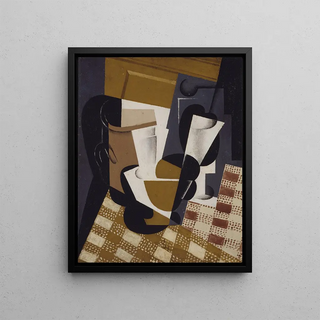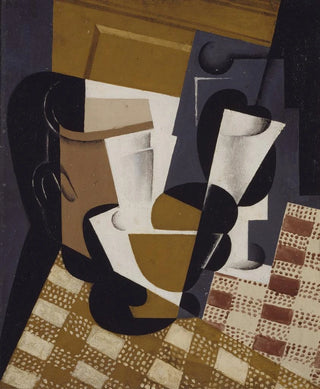Art print | Wine pitcher and glass - Juan Gris


View from behind

Frame (optional)
Reproduction of the Pichet à vin et verre by Juan Gris, created in 1914, exemplifies the cubist movement, an aesthetic revolution that redefined artistic conventions of the time. The piece, both complex and captivating, invites viewers to immerse themselves in a universe where forms decompose and recombine. Gris, a master of cubism, manages to capture the essence of reality through geometric facets, offering a new perception of space and everyday objects. Far from a simple depiction of a pitcher and a glass, this artwork evokes a true visual experience, where each element interacts with others in subtle harmony.
Style and uniqueness of the work
Juan Gris's style is distinguished by its precision and clarity, contrasting with the often complex nature associated with other cubist artists. In Reproduction, he employs a carefully selected color palette, oscillating between warm tones and cooler shades, to create an atmosphere that is both lively and soothing. The angular shapes, characterized by clean lines and overlapping planes, demonstrate impressive technical mastery. Each element, whether the pitcher or the glass, is broken down into volumes, allowing the viewer to approach the work from different angles. This innovative approach embodies the spirit of cubism, encouraging active contemplation and a renewed appreciation of familiar objects.
The artist and his influence
Juan Gris, born in Spain in 1887, established himself as one of the major figures of cubism, alongside Pablo Picasso and Georges Braque. His artistic journey, driven by a constant search for harmony and balance, has profoundly impacted the history of modern art. Gris combined abstraction with a certain poetry, transforming mundane scenes into compositions of great visual richness. His influence extends well beyond his era, inspiring generations of artists to explore new dimensions of perception and representation. Through works like Reproduction, he paved the way for a deeper understanding of the relationship between

Matte finish

View from behind

Frame (optional)
Reproduction of the Pichet à vin et verre by Juan Gris, created in 1914, exemplifies the cubist movement, an aesthetic revolution that redefined artistic conventions of the time. The piece, both complex and captivating, invites viewers to immerse themselves in a universe where forms decompose and recombine. Gris, a master of cubism, manages to capture the essence of reality through geometric facets, offering a new perception of space and everyday objects. Far from a simple depiction of a pitcher and a glass, this artwork evokes a true visual experience, where each element interacts with others in subtle harmony.
Style and uniqueness of the work
Juan Gris's style is distinguished by its precision and clarity, contrasting with the often complex nature associated with other cubist artists. In Reproduction, he employs a carefully selected color palette, oscillating between warm tones and cooler shades, to create an atmosphere that is both lively and soothing. The angular shapes, characterized by clean lines and overlapping planes, demonstrate impressive technical mastery. Each element, whether the pitcher or the glass, is broken down into volumes, allowing the viewer to approach the work from different angles. This innovative approach embodies the spirit of cubism, encouraging active contemplation and a renewed appreciation of familiar objects.
The artist and his influence
Juan Gris, born in Spain in 1887, established himself as one of the major figures of cubism, alongside Pablo Picasso and Georges Braque. His artistic journey, driven by a constant search for harmony and balance, has profoundly impacted the history of modern art. Gris combined abstraction with a certain poetry, transforming mundane scenes into compositions of great visual richness. His influence extends well beyond his era, inspiring generations of artists to explore new dimensions of perception and representation. Through works like Reproduction, he paved the way for a deeper understanding of the relationship between






